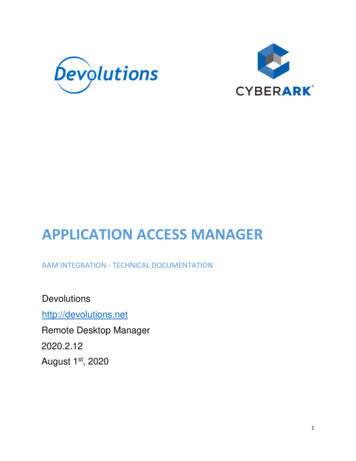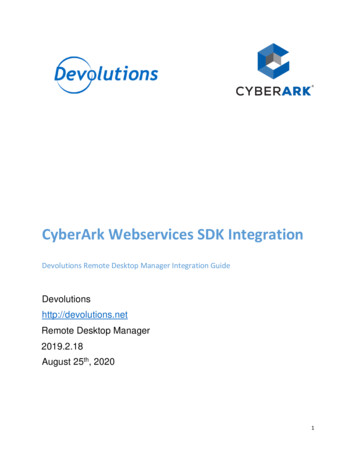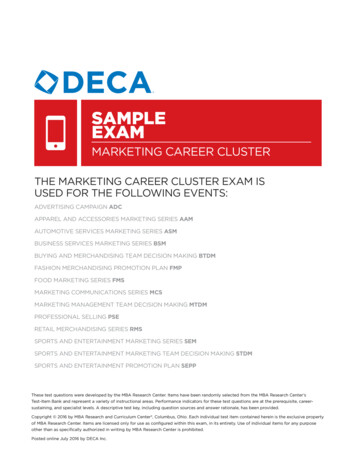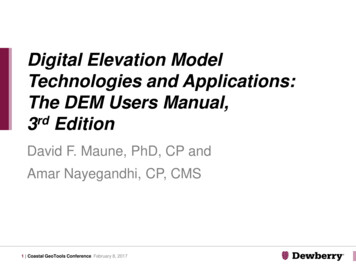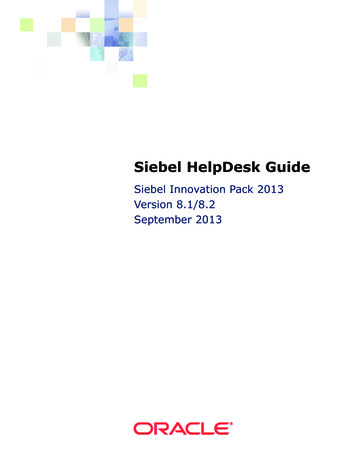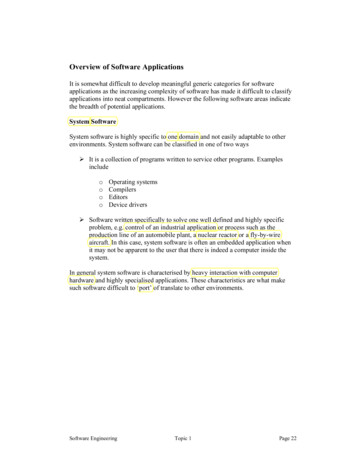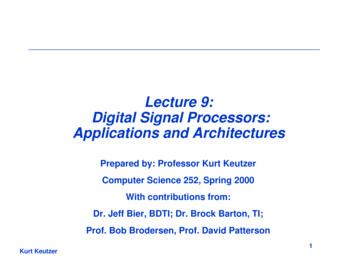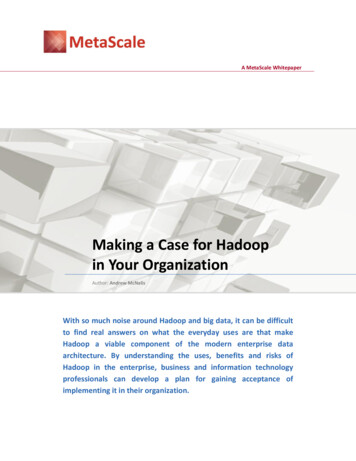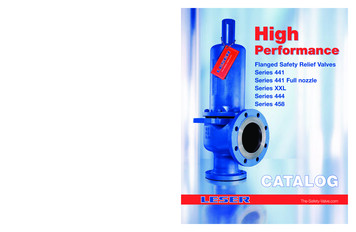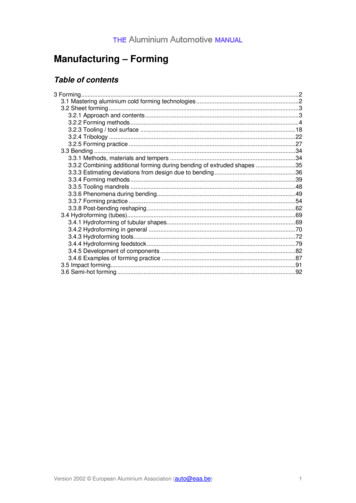
Transcription
Manufacturing – FormingTable of contents3 Forming.23.1 Mastering aluminium cold forming technologies .23.2 Sheet forming .33.2.1 Approach and contents .33.2.2 Forming methods .43.2.3 Tooling / tool surface .183.2.4 Tribology .223.2.5 Forming practice .273.3 Bending .343.3.1 Methods, materials and tempers .343.3.2 Combining additional forming during bending of extruded shapes .353.3.3 Estimating deviations from design due to bending .363.3.4 Forming methods .393.3.5 Tooling mandrels .483.3.6 Phenomena during bending.493.3.7 Forming practice .543.3.8 Post-bending reshaping .623.4 Hydroforming (tubes).693.4.1 Hydroforming of tubular shapes.693.4.2 Hydroforming in general .703.4.3 Hydroforming tools .723.4.4 Hydroforming feedstock .793.4.5 Development of components .823.4.6 Examples of forming practice .873.5 Impact forming.913.6 Semi-hot forming .92Version 2002 European Aluminium Association (auto@eaa.be)1
3 Forming3.1 Mastering aluminium cold forming technologiesMastering aluminium forming technologies, especially those performed at roomtemperature, is the key to successful high volume lightweight automotive engineering.While the principles of cold forming are equally applicable to all common metals, it isimportant to appreciate the differences as well.It is the objective of this Section to summarise the important cold forming technologiesapplicable to aluminium and point out the potentials and limits. Sheet forming of inner and outer closure panels summarises the experiences in partand tool design. Bending of tubes and shapes has become a key technology field in thedevelopment of space frames and other structural application using tubes andespecially extruded shapes as starting materials for complex shaped components. Hydroforming of tubes and extruded shapes has developed as important coldforming technology for aluminium components, particularly with respect to minimisingtolerances. Impact forming is of particular significance for aluminium extrusions, since it permitsto obtain local increases in cross-section, which otherwise must be attached byjoining techniques. Semi-hot forming - a necessity for magnesium - dramatically extends the forminglimits of aluminium. It may well become of more significance in the future.Version 2002 European Aluminium Association (auto@eaa.be)2
3.2 Sheet forming3.2.1 Approach and contentsAluminium alloy car body sheet materials can be cold formed using the same investments inequipment as for forming of steel sheet. However, aluminium sheet requires special attentiondue to its lower formability (when compared with mild steels), higher springback and surfacesensitivity in contact with forming tools.For difficult part designs the approach is to use special car body sheet qualities and shapes,adhere to allowable tool design features, select the right lubrication and follow establishedaluminium sheet forming strategies.Tips & tricks for successful aluminium car body sheet forming are summarised in this Sectionby DO-s and DON'T-s with respect to Forming methods Tooling Tribology and Forming practice.The contents are intimately related to information given in other sections of this Manual: see: Rolled products, see: Flow curve and formability, see: Joining see: Surface finishing.Version 2002 European Aluminium Association (auto@eaa.be)3
3.2.2 Forming methodsGeneral remarks on forming aluminium sheetSee also: AAM – Products – 1 Rolled products Flow curve, formability dataSpecific DOs and DON'Ts are presented for the following aluminium sheet formingmethods: Blank preparation Drawing Stretching Bending Flanging Hole expansion Embossing Feature lines Roll forming HandlingDesign of each operation must consider SpringbackDO use processes specifically designed for aluminium use geometries and methods suitable for aluminiumDON'T use straight substitution of steel by aluminiumSee also chapter "Flow curve & formability".Strain distribution in aluminium product as simulated by DiekAVersion 2002 European Aluminium Association (auto@eaa.be)4
Blank preparationLiterature: Furrer, P. and Bloeck, M.: Aluminium-Karosseriebleche. Landsber: Verl. ModerneIndustrie, 2001, (Die Bibliothek der Technik; Bd. 220) ISBN 3-478-93250-5Blank preparation concerns blanking, washing, etc.DO For critical stampings use EDT finish of 1.5 mm. EDT reproducibly shows betterforming and paint appearance. Use developed blanks rather than rectangular ones to improve formability andspringback predictability.Developed blankSource: AlcanDON'T Use more than 1.5 mm of roughness: it will cause blanks to fret and paint appearancewill worsen.EDT surface topographySource: Corus GroupVersion 2002 European Aluminium Association (auto@eaa.be)5
DrawingLiterature: Schuler GmbH: Handbuch der Umformtechnik. Berlin: Springer-Verlag, 1996. ISBN 3540-61099-5 K. Siegert (Hrg), Neuere Entwicklungen in der Blechumformung. SymposiumStuttgart 1992., Oberursel: DGM Informationsgesellschaft-Verlag, ISBN 3-88355-1821 Siegert, K. (Hrg.), Neuere Entwicklungen in der Blechumformung SymposiumStuttgart 1996, Oberursel: DGM-Informationsgesellschaft-Verlag, 1996Drawing, or deepdrawing, is a forming method, where the shape is stamped into a sheet bymeans of dies allowing for the material to flow inwards.DO Use of a developed blank minimises formability and springback problems. Drawbeads can be used to control material flow.DON'T Be careful not to induce too much strain in areas where flanges will be later on. Bothfor flanging and for clinchabilitySingle acting drawing tool setupCourtesy: Schuler GmbHVersion 2002 European Aluminium Association (auto@eaa.be)6
StretchingStretching, is a forming method stamping the shape into a sheet by means of dies restrictingthe material from flowing inwards.DO Make sure a minimum strain of 1-2% is obtained in the whole panel for dentresistance and tightness. Use lockbeads wherever possible to achieve this However, using bakehardenable material the dent resistance will be largelyindependent of strain Try and achieve uniform strain distribution for dimensional quality and predictablespringbackDON'T Be careful not to induce too much strain in areas where flanges will be later on. Bothfor flanging and for clinchabilityIncrease in dent resistance of exterior panel with plastic strainSource: Corus GroupVersion 2002 European Aluminium Association (auto@eaa.be)7
BendingBending is a forming method in which positive strain develops on one side and negative strainon the other. Average strain is zero, so length remains intact.Bending can be done in several ways: free bending (here), die bending (here) or flanging (next page).DO Layout cutting process such as to have the cut edge on the outside radius of thebend, i.e. the burr on the inside Set inner radius to 3t if in doubt of capabilities of the alloy of choiceDON'T Bend along a line in rolling direction (RD) if you can avoid it. Because this willincrease orange peelV-bending (left) and die-bending (right), schematicallyVersion 2002 European Aluminium Association (auto@eaa.be)8
Straight flangingFlanging is the forming (bending) of flanges to a panel using stamping techniques.DO Calculate the outside strain byεβ 1/2 ln(1 t/Ri)This accounts for the shift of the neutral plane in bending. Thickness is t and innerradius of flange is Ri Compare the strain εβ to the uniaxial elongation A80. When εβ is smaller than A80,there is absolutely no problem. This criterion is very conservative and hence higherstrains might be allowed with care Have a nominal clearance of 5% of tDON'T Use downflange radius less than 2 t, if panel is to be hemmed 180 degrees (smallerradii can however be reached with optimised aluminium products)Schematic straight flangeVersion 2002 European Aluminium Association (auto@eaa.be)9
Stretch flangingStretch flanging is the flanging operation performed on a (partial) hole.DO Calculate maximum strain at edge of the hole from ε ln(R2/R1). Where R1 is innerradius of hole prior to flanging; R2 is radius after flanging Make sure this strain is less than elongation A80. Unlike in straight flanging this is nota conservative criterionDON'T If the flange is to be hemmed 180 degrees subsequently, the final strain will be twicethe now calculated oneSchematic stretch flangeVersion 2002 European Aluminium Association (auto@eaa.be)10
Shrink flangingShrink flanging is a flanging operation on a concave edge.DO Shrink flanges are prone to wrinkling. Critical strain is limited to:R is radius of panel, flange angle (usually 90 degrees), K and n stem from Hollomon's law.E is the elastic modulus and Poisson's ratio.DON'T Subsequent hemming to 180 degrees will set sin to 2 in the formula on the leftSchematic shrink flangeVersion 2002 European Aluminium Association (auto@eaa.be)11
Hole expansionHole expansion is comparable to stretch flanging. However, it can also be achieved using aconical punch (JFS-T1001-1996).DO For high hole expansion ratios in aluminium use a conical punch comparable to theone used in the JFS norm. Calculate maximum strain at edge of the hole from ln(R2/R1). Where R1 is innerradius of hole prior to flanging; R2 is radius after flanging.Version 2002 European Aluminium Association (auto@eaa.be)12
EmbossingEmbossments are brought in local features pressed in at the end of the forming process bypure stretching.DO Estimate strain from surface change between flat sheet and embossment. Make surethis strain is well below FLD.Version 2002 European Aluminium Association (auto@eaa.be)13
Feature linesFeature lines, or plane strain embossments are stretched in only one direction.DO Assuming no movement outside the feature: calculate line length along feature L andline length without feature present L0. Estimate strain from these lengths as ln(L/L0). Make sure this strain is less than1/2 FLD0.Example length calculation over feature lineVersion 2002 European Aluminium Association (auto@eaa.be)14
Roll formingRoll forming is the continuous forming of sections through subsequent roll sets.Aluminium profiles are often extruded but sheet alloys can be stronger.DO Obey minimum bending radii as found in suppliers data sheets. In general R/t 3 isconsidered to be safe Set relaxed tolerances on large radii in the cross section, because they are difficult tomaintain Stiffen wide sections by adding local bendlinesDON'T Use extruded profiles where strength is needed Try forming short legs with roll forming Use narrow high rolls if it can be avoided, to prevent breakingSchematic of roll formed profileVersion 2002 European Aluminium Association (auto@eaa.be)15
HandlingHandling refers to all secondary processes in transport of material in between forming steps.DO Take care in handling aluminium. It easily scratches. Preferably use a dry-film lubricant to avoid scratches instead of a paper interlayer.DON'T Simply use steel handling installations available.Version 2002 European Aluminium Association (auto@eaa.be)16
SpringbackSpringback refers to the phenomenon of shape change after forming due to residual stresses.DO Use drawbeads / lockbeads to induce 1-2% strain in the whole of the panel. Induce some stretching to alleviate springback due to bending stresses.DON'T Overlubricate, this will reduce friction so less strain can be induced and springbackwill be worse.Springback scales linearly with stress level and elastic modulusHowever, lager thickness reduces bending springbackVersion 2002 European Aluminium Association (auto@eaa.be)17
3.2.3 Tooling / tool surfaceDraw beadsDraw beads are used to restrict the material flow into a die cavity. By restricting the flow, morestretching strain can be induced in the centre of panel, and a tighter appearance is achieved.DOUse the following general design rules:Typical radii used in draw beads for aluminium body panels:R1 3 to 6t; R2 6t; B1 12t; B2 15t; h 6 to 10t.With: t sheet thicknessThe centre of the draw bead is traditionally placed about 25 times the sheet thickness fromthe side of the draw die (punch opening line). The radius at this side should be 5 to 10 timesthe sheet thicknessVersion 2002 European Aluminium Association (auto@eaa.be)18
Lock beadsLock beads are used to completely stop the material from flowing into the die cavity. In thisway all deformation is stretching deformation. This ensures ensuring a panel to be as tight aspossible.DOUse following general design rules:Typical radii used in lock beads for aluminium body panels:R1 3t; R2 2t; B1 12t; B2 15t; h 6t.With: t sheet thicknessThe centre of the lock bead should be placed about 24 times sheet thickness from the side ofthe draw die (punch opening line). The radius at this side should be at least 9 times sheetthickness.Version 2002 European Aluminium Association (auto@eaa.be)19
RadiiDie and punch radii should generally be chosen a bit larger when compared with radii for steelsheet of the same thickness.DOUse following general design rules:R 10 times sheet thickness for low ribs (h 20 mm)R 15 times sheet thickness for high ribs (20 h 30 mm)Rcorner 20 times sheet thicknessVersion 2002 European Aluminium Association (auto@eaa.be)20
Tool material & coatingChoice of tool material is wide, coating is most important for performance.DO Preferably use cast steel as tool material Consider using a coating on the tooling: Japan & North America commonly usechrome plating. Alternatively nitriding, or titanium nitride, vanadium nitride or titaniumcarbide may be applied. Also consider DLC coatings as an alternative.DON'T simply use flame hardened cast iron. Cast iron has a porous surface which will causemarks on the sheets when drawn.Version 2002 European Aluminium Association (auto@eaa.be)21
3.2.4 TribologyIssue of the tool / sheet interfaceSee also: AAM – Manufacturing – 4 Surface finishing Pre-conditioning of Al-forms Sheet /stripTribology is concerned with the behaviour of the tool / sheet interface. It includes friction,lubrication and wear topics of the sheet / tool interface.Tribological aspects (can) have a major influence on the forming characteristics of a part.Information on important tribological factors and phenomena can be found under the followingtopics: Friction Galling Lubrication Surface roughnessDO Use lubrication, suitable for processing aluminium.Consider using a dry-film lubricant.Use optimised surface roughness texture, eg. EDT.Take into account that Aluminium generally shows lower friction than steel.Take into account all sheet-lubricant- tool-process parameters when analysing thefrictional behaviour of the sheet/tool interface.DON'T Use the same tooling used for steel panels regardless. These are very likely to beunsuitable for friction, wear and due to more general formability issues. Dedicatedtooling material and/or geometry is usually required.Version 2002 European Aluminium Association (auto@eaa.be)22
FrictionThe friction and wear behaviour is clearly a system characteristic. The friction and the wearof an aluminium sheet material do not exist.Friction under sheet metal forming conditions is mildly dependent on contact pressure andsliding speed. However, all properties of sheet material and the tool (mech. properties,coatings, roughness, geometry) and also lubricant properties and operational (process)conditions (e.g. temp.) should be taken into account.Different kinds of surface textures that influence the friction (MF, EDT) can be applied toaluminium.The friction coefficient is mainly determined by the lubrication regime. In case all the normalload is carried by the lubricant film (i.e. full film lubrication) then friction is relatively low (EHL elasto-hydrodynamic lubrication). However, in case the entire load is carried by direct metalto-metal contact of tool and sheet metal (i.e. boundary lubrication, BL) then friction is muchhigher. Commonly, the lubrication regime during deep drawing of aluminium is somewherebetween full film and boundary lubrication (i.e. mixed lubrication, ML).Stribeck diagram, illustrated with different ratios of film thickness to roughness RaSource: CorusVersion 2002 European Aluminium Association (auto@eaa.be)23
GallingGalling is the type of wear in which transfer of material from one contact surface to the othertakes place. In Sheet Metal Forming: from sheet to tool. Ultimately this will cause severedamage to the sheet surface.Severe scratches in the direction of sliding arise from the ploughing of tiny sheet materialparticles, sticking to the tool surface.Galling also implies more frequent tool inspection and thus production interruption.Galling can be reduced by avoiding direct metal-to-metal contact between the sheet and thetool. This can be achieved by pre-coating aluminium or alternatively by applying sheet with acertain roughness, which is capable of generating micro-pockets containing lubricant. Thesemicro reservoirs may act as a source of extra lubrication in the process of severe asperityflattening. This favours certain surface textures like EDT above MF.Avoid sharp edges and radii (i.e. high pressures), apply tool coatings. Polish the surface.Typical scratch pattern on sheet as a result of gallingVersion 2002 European Aluminium Association (auto@eaa.be)24
LubricationSome form of lubrication is usually needed to reduce friction and avoid galling. This can beliquid based, usually mineral oil based. Alternatively, dry-lubricants are gaining popularity.Severe flattening of the asperities under friction causes this different behaviour of aluminiumcompared to uncoated steel. Due to this flattening, a small amount of lubricant is alreadysufficient to induce mixed lubrication. As a result of all this, in deep draw operations thefriction in the blank holder can become extremely low if sufficient lubricant is applied. Pureboundary lubrication is hard to obtain.Dry lubricants show a more stable frictional behaviour than mineral fluids. Regardless ofconditions these systems retain the same friction coefficient (s. fig. below). This is usuallygood for process stability. The frictional behaviour is hardly influenced by minor processvariations.Dryfilm lubricant vs 'oil' on different materials in the Renault Multifrottement testFig. (above): Multi-friction-test, number of passes between flat and cylindrical tool. Steepincrease of Coeff. of Friction for mineral fluids demonstrates the effect of galling.Version 2002 European Aluminium Association (auto@eaa.be)25
Surface roughnessRoughness and waviness have an impact on paint appearance of sheet material.Apart from that, it also has an influence on the frictional and wear behaviour during forming.The difference in frictional behaviour of EDT and MF is due to the difference in roughnesslevel (EDT: Ra 1µm, MF: Ra 0.4 µm), the directionality of MF and the difference in closedvoid area fraction / volume (3D roughness).One would expect a lower friction for lower Ra values. However, the fig. below demonstratesthat this is not true. The randomness and the higher content of closed voids of EDT comparedto MF are of major influence on the level of friction. Therefore, 3D roughness cannot beneglected in understanding tribological behaviour.Version 2002 European Aluminium Association (auto@eaa.be)26
3.2.5 Forming practiceTips & tricksForming practice is concerned with the practical tips & tricks to get the forming process todeliver the panels and deliver them with the desired quality.DO All practical forming principles for steel equally apply to aluminium. As aluminium is generally less formable than the traditional low strength steels morecare in process design is needed. The emphasis on some questions may be different in aluminium than in steel. Forinstance springback will be a larger problem in aluminium. On the other hand presstonnage will generally be less.DON'T use an existing tool for drawing steel panels to evaluate the (possible) performance ofaluminium.Version 2002 European Aluminium Association (auto@eaa.be)27
Minimum strainFor a tight appearance, especially important in outer panels, a minimum equivalentstrain of 2% is recommended.DO use drawbeads or lockbeads to achieve minimum required strain. Controlling strainby beads is more robust than by blank holder force (BHF). Static dent resistance also increases with a strain and more than 2% may befavourable from this point of view. Edges are easily stretched. Extra lubrication on the punch may put more strain in themiddle of the panel as well.DON'T try inducing the minimum strain by stretching in one direction. Equibiaxial stretching isneeded for best results.Schematic strain distributionVersion 2002 European Aluminium Association (auto@eaa.be)28
FlangingFlanging induces high strain levels in the material. If flange areas had been deformedsignificantly in the previous operations, tearing problems may occur.DO Avoid excessive straining on points were later on flanges will be formed.Surface of a flat hem of sheet alloy 6016-T4Source: Corus GroupVersion 2002 European Aluminium Association (auto@eaa.be)29
StorageStorage of material also influences formability.DO In winter: bring material in a room temperature environment appr. 24 hrs beforepressing. Low temperatures decrease ductility markedly. Scratches occurring during transport of blank on e.g. a pallet can be avoided byspecifying dry lube's. These provide much higher resistance to scratching than oildoes.DON'T carelessly transport aluminium blanks without any inter sheet protection. They willeasily scratch. A paper sheet, some oil or (preferably) dry lube is much better.Version 2002 European Aluminium Association (auto@eaa.be)30
Developed blanksIn applications which are critical due to limited formabilty for aluminium (whencompared to low strength steel) developed blanks (also called form blanks) arerecommended.DO Use a developed blank when splitting problems are experienced. Make sure the cutting edges of the tool used to cut the developed blank are sharpand clean. Otherwise build up or galling eventually produces slivers which will scratchand cause pimples in the drawing operations.DON'T save on washing & re-oiling after blanking. Even with sharp knives the oldcontamination will get on the sheet leading to pimple problems in drawing.Version 2002 European Aluminium Association (auto@eaa.be)31
Extra lubricationUse of extra lubrication in the process will add cost but makes the process morerobust.DO Add extra / controlled amount of lubricant if much variation in process performance isseen or expected. This may be due to redistribution of oil during transport. Oiling both sides of the blank reduces the risk of fretting during transport.DON'T use manual application or redistribution of oil using a cloth. This may contaminatesheet surface and cause pimples in drawing.Version 2002 European Aluminium Association (auto@eaa.be)32
Strain uniformityStrain uniformity enhances predictability and dimensional accuracy.DO Aim for as uniform a strain as possible. Strain distribution can be measured by opticalmeasurements of grid patterns. Commercially available systems include circle grid,ASAME and PHASTTM. This will increase dimensional quality, as well as the predictability of springback,though not necessarily the amount of springback.DON'T try to achieve low springback at the cost of strain uniformity. Even if springback islower, its variability is higher and control is more difficult.Version 2002 European Aluminium Association (auto@eaa.be)33
3.3 Bending3.3.1 Methods, materials and tempersLinks: AAM – Manufacturing – 3 Forming Semi-hot forming AAM – Materials – 2 Alloy constitution Heat treatment Retrogression heattreatment AAM – Manufacturing – 3 Forming Hydroforming (tubes)Automotive tubing and extruded profiles are rarely used in as-fabricated straight lengths. Tocomply with design requirements, various forming techniques are employed. The mostfrequent forming operation is bending - often succeeded by mechanical local reforming,calibration and sometimes hydroforming.Bending of tubes and extruded shapes can be performed with various methods suitable forthe purpose.To achieve the required end form and tolerances, attention must be paid to toolingtechniques, but also to the shape design required for optimum forming behaviour.Bending of tubes and shapes is mostly done by cold forming. Depending on the formabilityrequirements the material must be supplied in a suitable temper.For large degrees of cold forming the following tempers may be selected from: Non-heat-treatable alloys (3xxx and 5xxx): soft tempers (O, H111, H112) Heat-treatable alloys (6xxx, 7xxx): solution annealed, quenched and naturally aged(T4). If in-line process heat treatment facilities are available, the as-quenched (W)temper, RHT or re-solution heat treatment procedures may be used.While cold forming is usually preferred, forming at moderately high temperatures, sometimesby localised heating, can be used to improve the material's formability.Note, however, that any thermal treatments during processing change the microstructure andproperties. Therefore, care should be exercised to avoid detrimental effects on designproperties.Post-bending re-shaping may offer a variety of solutions for part forming and must beconsidered in the design of the cross-section shape.Version 2002 European Aluminium Association (auto@eaa.be)34
3.3.2 Combining additional forming during bending of extrudedshapesBending of tubes is a well established technology and due to their rotational symmetry, tubescan be bent with equal force and spring back around any axis. As regards non-tubularshapes, the situation is different. Therefore, high volume ( 10000 pcs./yr.) production untilnow, to a large extent, has been bending around one axis - 2D. However, high volume 3Dbending of profiles is under development.Bumper beams (s. figure at right) have for years been 2D bent in high volumes in high speedforming lines. Included in the forming lines are also: pre-cutting (removing material before bending), solution heat treatment (applied to 7xxx-series alloys) punching holes and removal of external webs and flanges, various embossments,and calibration operations, mounting of fastening elements like steel nuts, mechanical joining of various brackets.Bumper beamsCourtesy: Hydro Automotive StructuresVersion 2002 European Aluminium Association (auto@eaa.be)35
3.3.3 Estimating deviations from design due to bendingBending defects like sagging or local buckling (wrinkling) of flanges, undesirable wallthinning or elastic spring back are estimated by simple design formulas or determinedmore accurately by use of Finite Element Analysis.Design formulas for predicting bendability are especially useful for quick and relativelyaccurate estimates of hollow sections.An overview of important parameters with respect to bendabiliy of rectangular hollow sectionsfollows below (pure bending):Design formulas for pure bendingwhere:b width of sectionh height of sectiont wall-thicknessR bending radiusE Young's modulusI second moment of inertia yield stress (0.2% offset)n hardening coefficientD diameter of tubeExamples of the design formulas for rough calculation of sagging and buckling depth of asingle chambered hollow section are incorporated in the design diagrams sho
3.2 Sheet forming 3.2.1 Approach and contents Aluminium alloy car body sheet materials can be cold formed using the same investments in equipment as for forming of steel sheet. However, aluminium sheet requires special attention due to its lower formability (when
